I’m the kind of guy who’s used to work with 16:9 for like an eternity, while I’m also still getting used to 21:9 displays. Work dictates that I really need an ultrawide display. Now when Lenovo decided to send us the Y44W-10 for review, we were shook with its 32:10 aspect ratio. The widest gaming monitor we’ve seen to date with a 44″ real-estate to back it up. Suffice to say those features on their own are already kind of a huge feat.
Now, the Lenovo Y44W-10 features a resolution of 3840 x 1200. That’s effectively two 1920 x 1200 panels with an aspect ratio of 32:10. Pixel pitch is at 0.274 mm with an effective DPI of 92.7. This is a VA panel, with 4ms of GtG response time and 144Hz refresh rate. The display comes with AMD FreeSync 2 support and a built-in KVM switch as well. Ready for multi-system setups.
Technical Specifications
| Display | |
| LCD Size | 43.4″ |
| Aspect Ratio | 32:10 |
| Resolution | 3840 x 1200 |
| Refresh Rate | 144Hz (Adaptive) |
| Pixel Pitch | 0.274mm |
| Brightness | 450cd/㎡ |
| Contrast Ratio | 3000:1 |
| Panel Type | VA (1800R) |
| Response Time | 4ms (GtG) |
| Color Space | Wide |
| Color Depth | 8-bit + FCR |
| Backlight | LED |
| Connectivity | |
| Display Options | 1x DisplayPort 1.4, 2x HDMI 2.0 |
| USB | 1x USB 3.1 (Type-C, DisplayPort 1.4), 1x USB 3.0 (Type-C, DisplayPort 1.2) 4x USB 3.0 |
| Audio | 1x 3.5mm (Audio Out) |
| Ergonomics | |
| VESA Mount | 100 x 100mm |
| Pivot | NA |
| Swivel | -20°/+20° |
| Tilt | -5°/+22° |
| Lift | 0-130mm |
| Dimensions | |
| Length | 1058mm |
| Width | 137mm |
| Height | 366mm |
| Weight | 13.33 kg (With stand), 9.33kg (Without stand) |
Packaging and Accessories
The Lenovo Legion Y44W-10 comes packed inside a huge packaging, similar to that of a slim fridge. It’s that huge. The product should come with the following items inside:
- Power cord
- Power adapter
- DisplayPort cable
- HDMI cable
- USB cable
- Harman Kardon certified speaker
Design, Layout and Build Quality
The Legion Y44W-10 is a good looking ultra-wide gaming display. It’s kinda simple yet it also got some hints of gamer slash industrial styling particularly with the stand’s design. Again, this is a 44 incher, so a spacious desk is required. If your current setup could fit two 24 inch monitors, then you are most likely ready for this one.
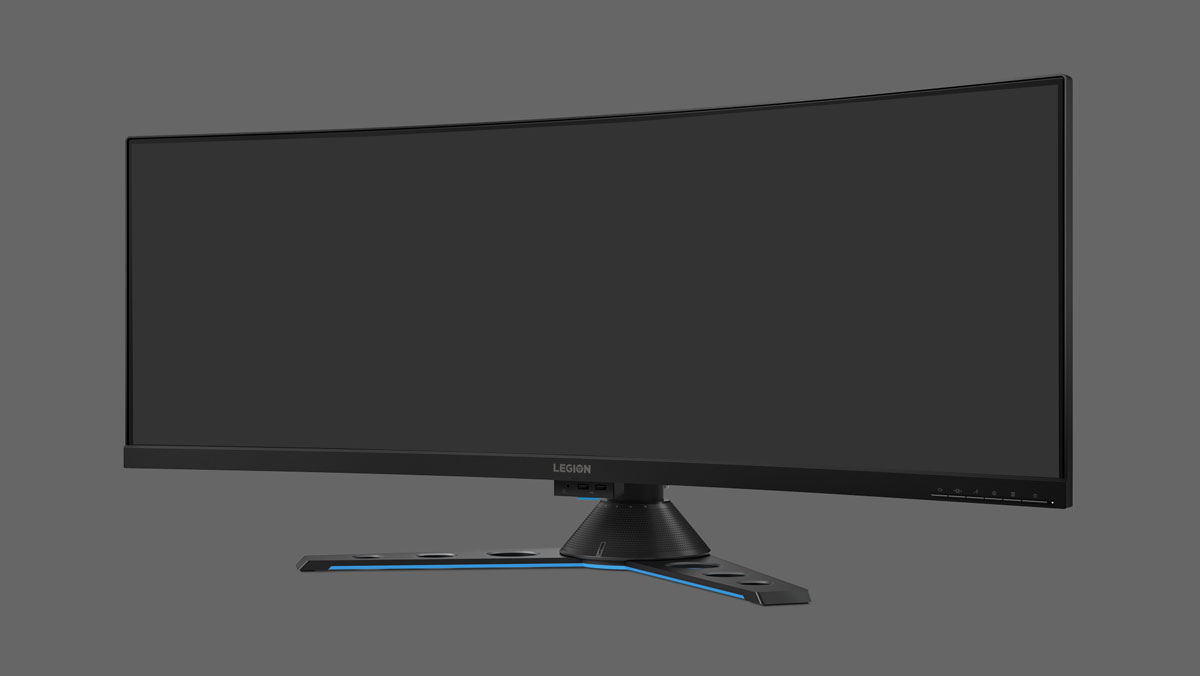
Lenovo utilized a blend of gloss and a matte finish for the Legion Y44W-10’s coating. Light AG coating is a usual feature found on most displays due to its ability to reduce glare while still maintaining vivid color and contrast. Curvature on the other hand is again 1800R. An excellent choice for a 44 incher with a 32:10 aspect ratio display.
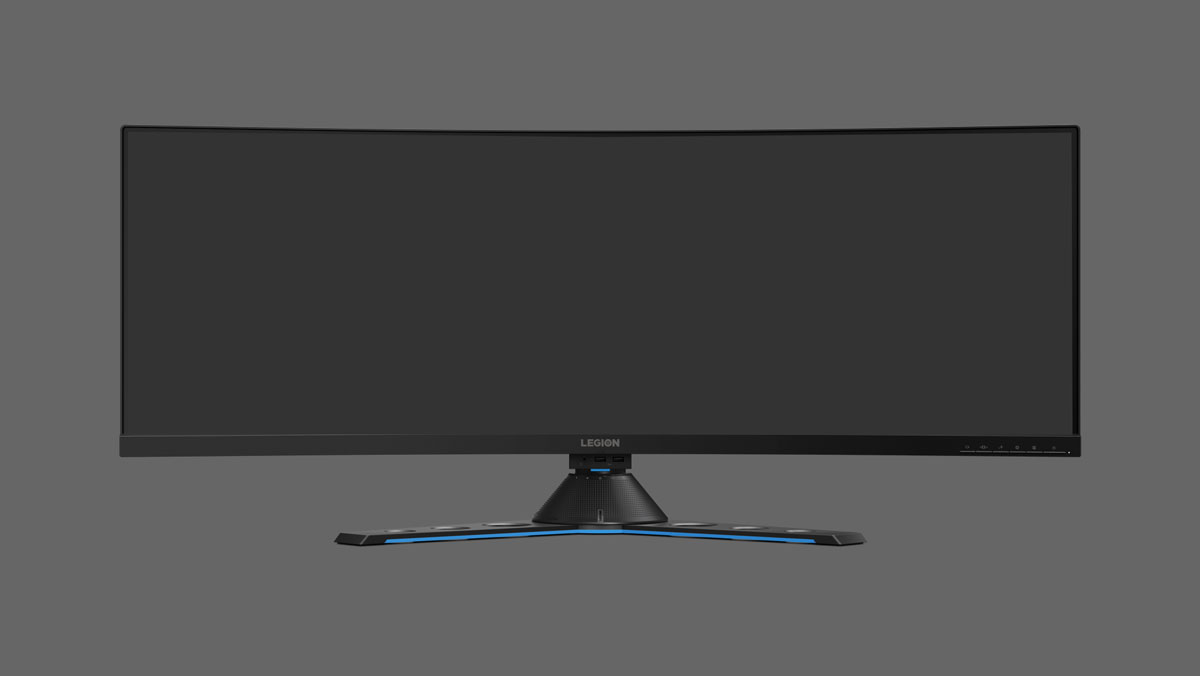
Ergonomically speaking, the Y44W-10 could tilt, swivel and lift. No pivot option here though but that’s a given for the size. On top of this, Lenovo included support for a 100mm VESA mount so if you want to maximize ergonomics, that is the only option available. Now the holes at the back are not for aesthetics alone. These are proper meshed openings, serving to keep the panel cool at all times.
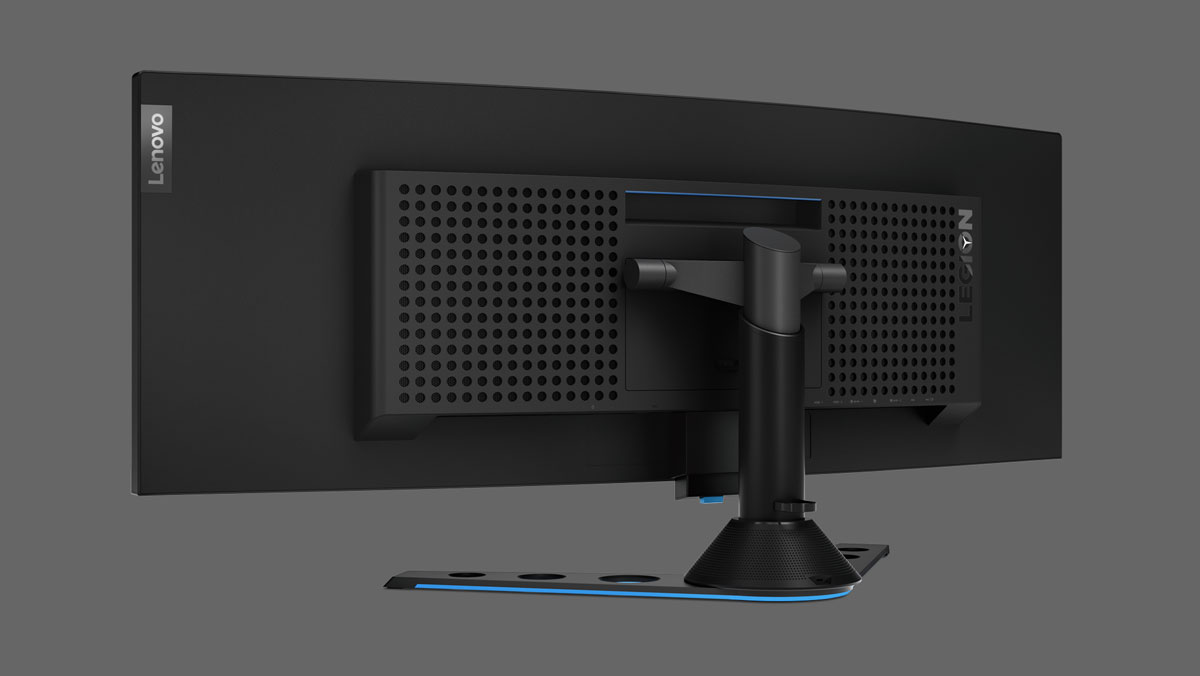
As for display options, Lenovo went out blasting with this one. We have dual HDMI 2.0 ports, a single DP, dual USB Type-A and dual USB Type-C ports. The Type-C ports are of course USB 3.0 and 3.1, capable of DisplayPort 1.2 and 1.4 connectivity. Basically, you get triple DP functionality with the Y44-10W.
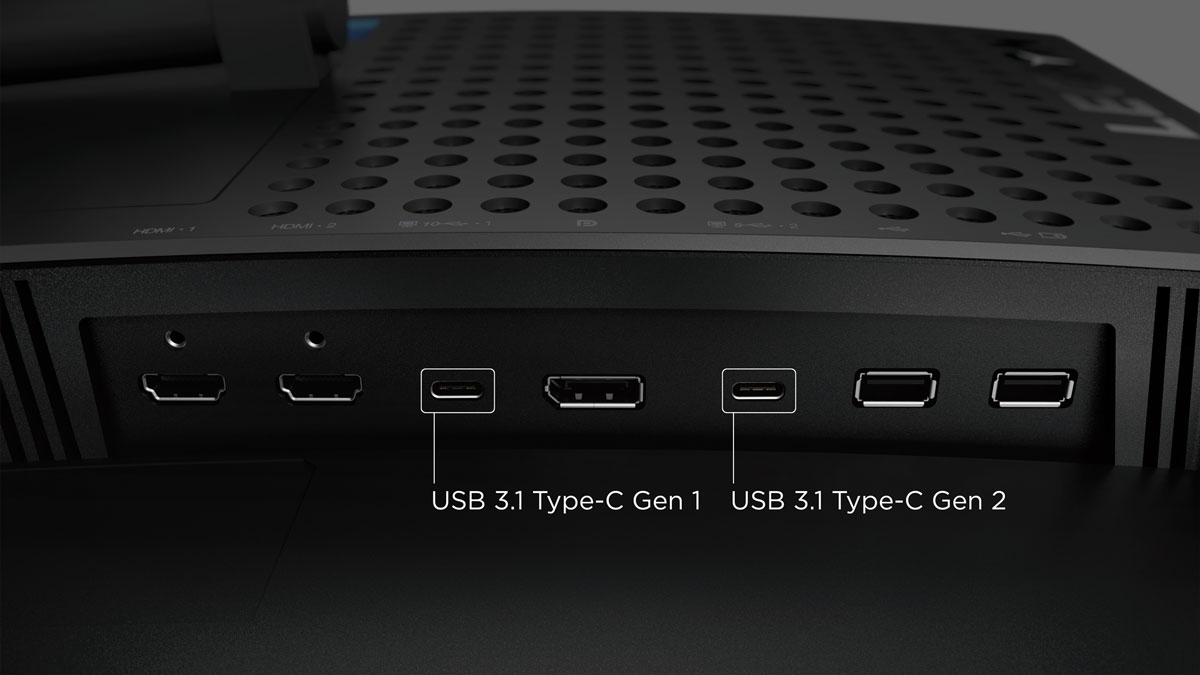
Up front are the two extra USB 3.0 ports and the audio out as well. This is a much appreciated feature for the built-in PIP and PBP modes together with the switch for the KVM functionality.
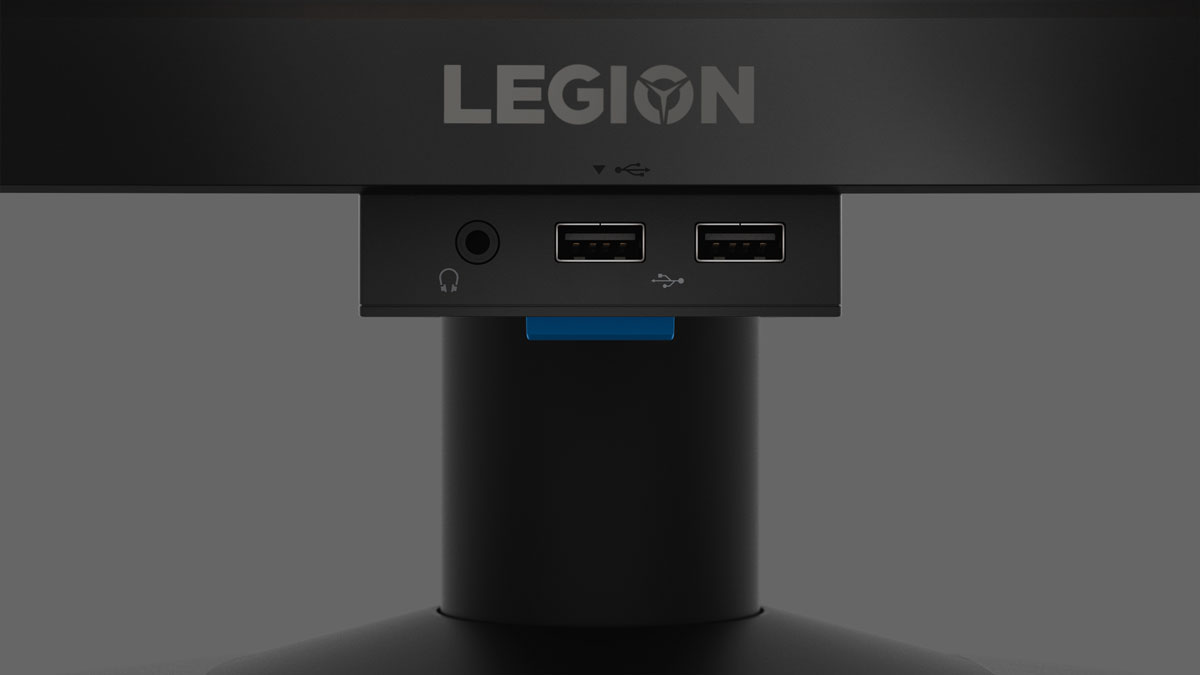
On-Screen Display Menu
The Lenovo Legion Y44W-10 features six frontal buttons instead of a joystick to navigate the OSD. A bit harder compared to let’s say an ASUS ROG monitor. It has its merits though, featuring a brightness and video source shortcut buttons. Now we have 5 main menus here with the Display settings featuring the most comment settings. Note that depending on your profile and selected color setup, some of these options will be grayed out.
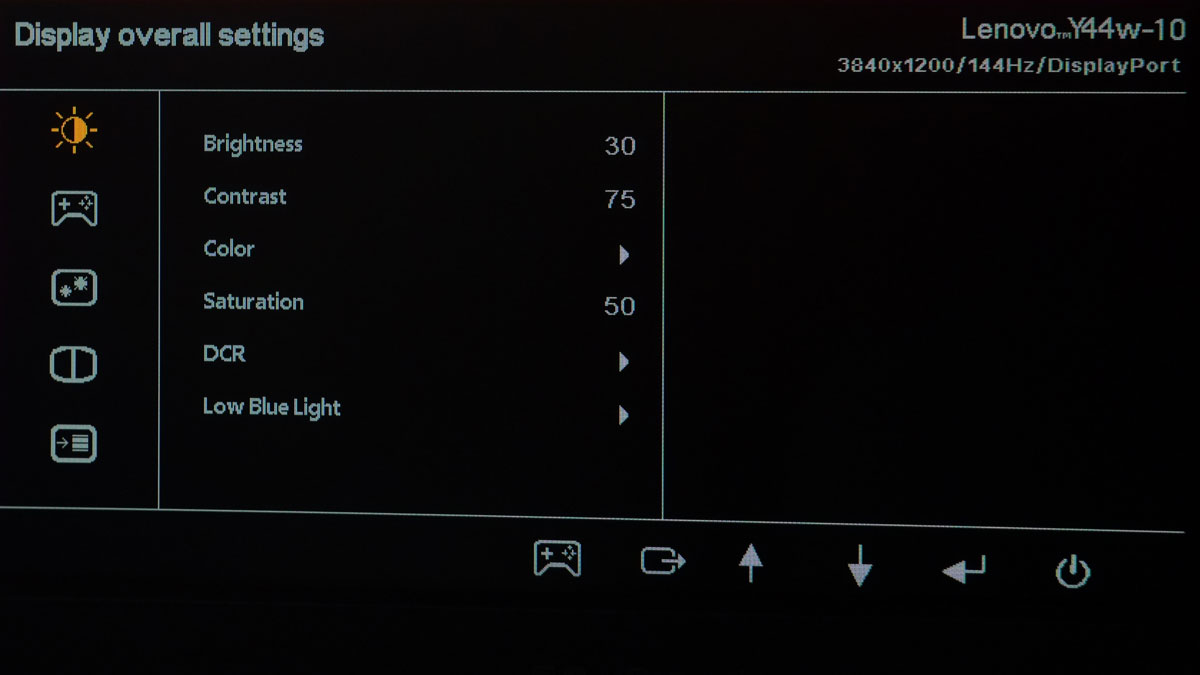
Gaming is the next one, offering overdrive and a funny HDR setup. It’s only available on auto or disable. Overdrive doesn’t matter much either. I just cant see the difference between the two modes.
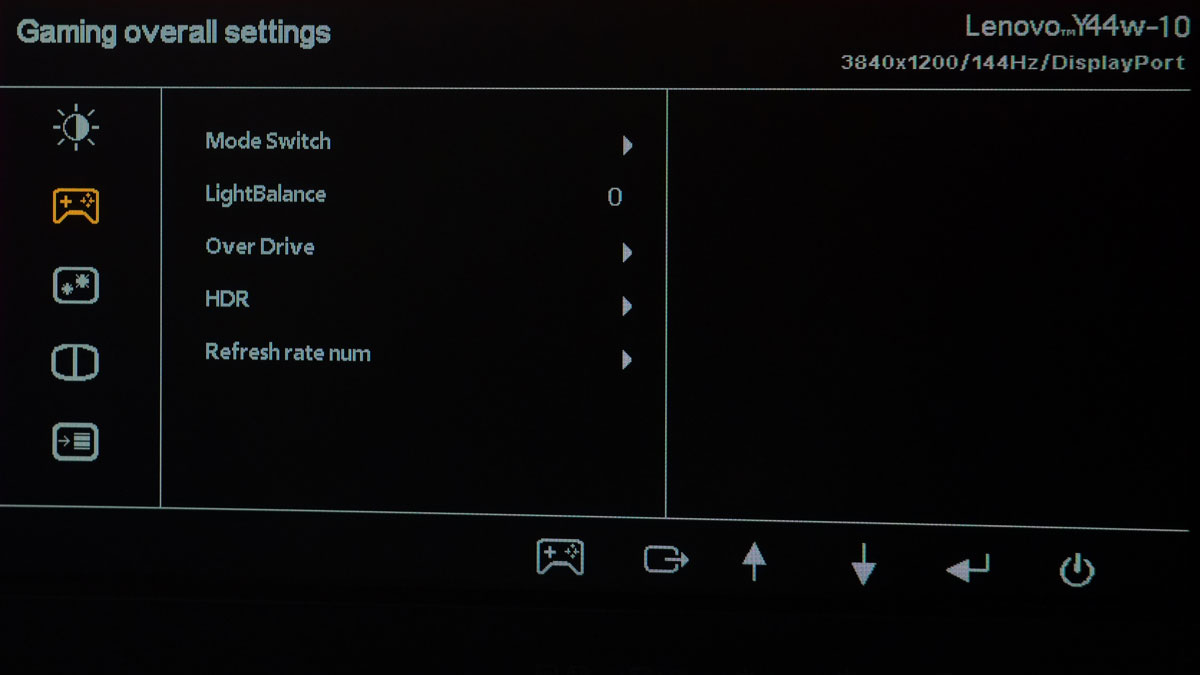
Advanced is more about the well, advanced options. We have scaling settings here as well as loads of USB options particularly in the power department.
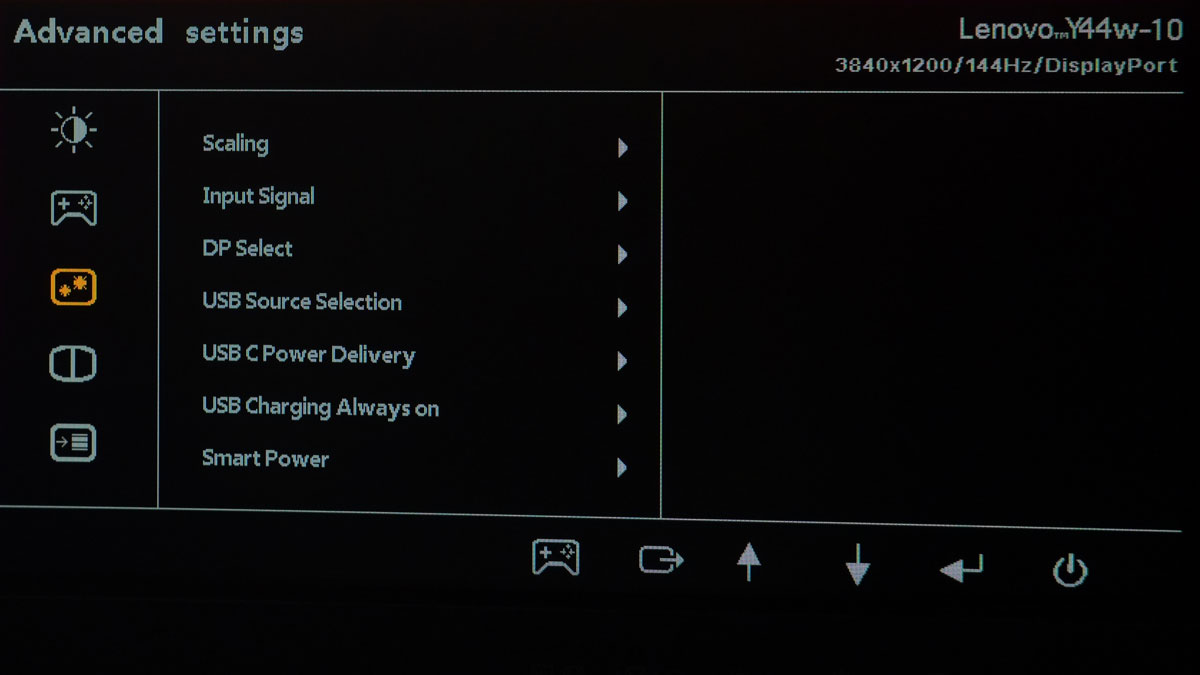
There is also a separate menu for Picture-In-Picture and Picture-By-Picture modes. This is a much appreciated cluster of features since the Y44W-10 is tailor made to house such.
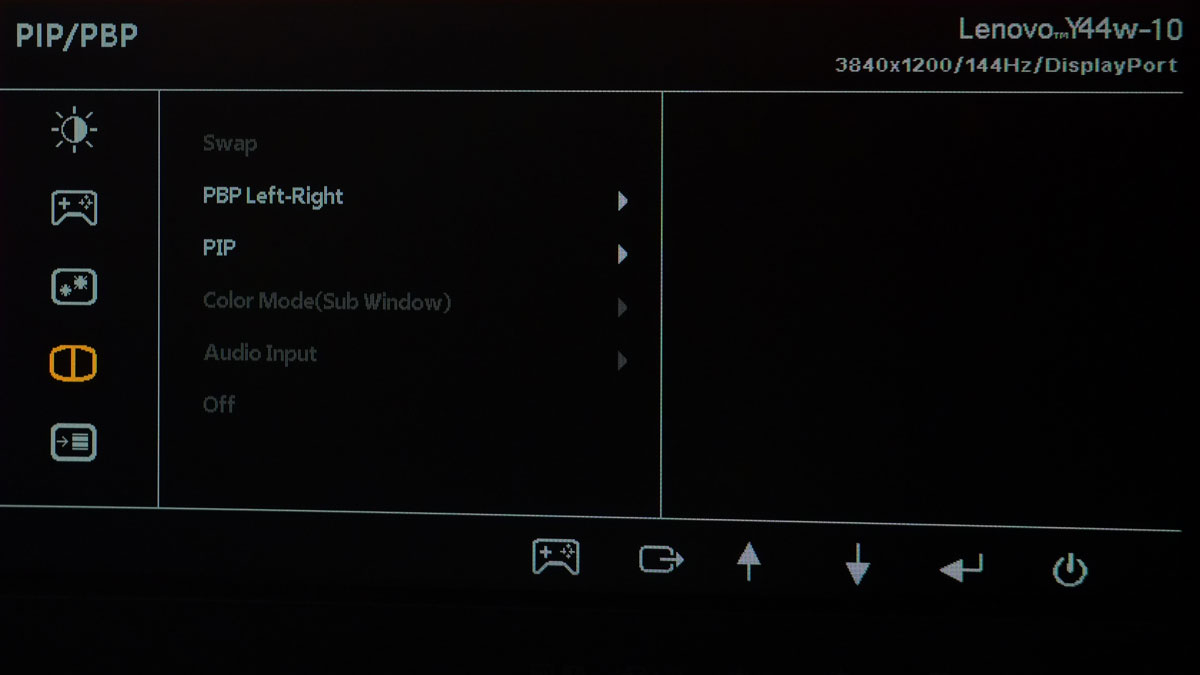
Lastly, we have the Options menu. This is self explanatory yet we really appreciated the accessibility features built right in.
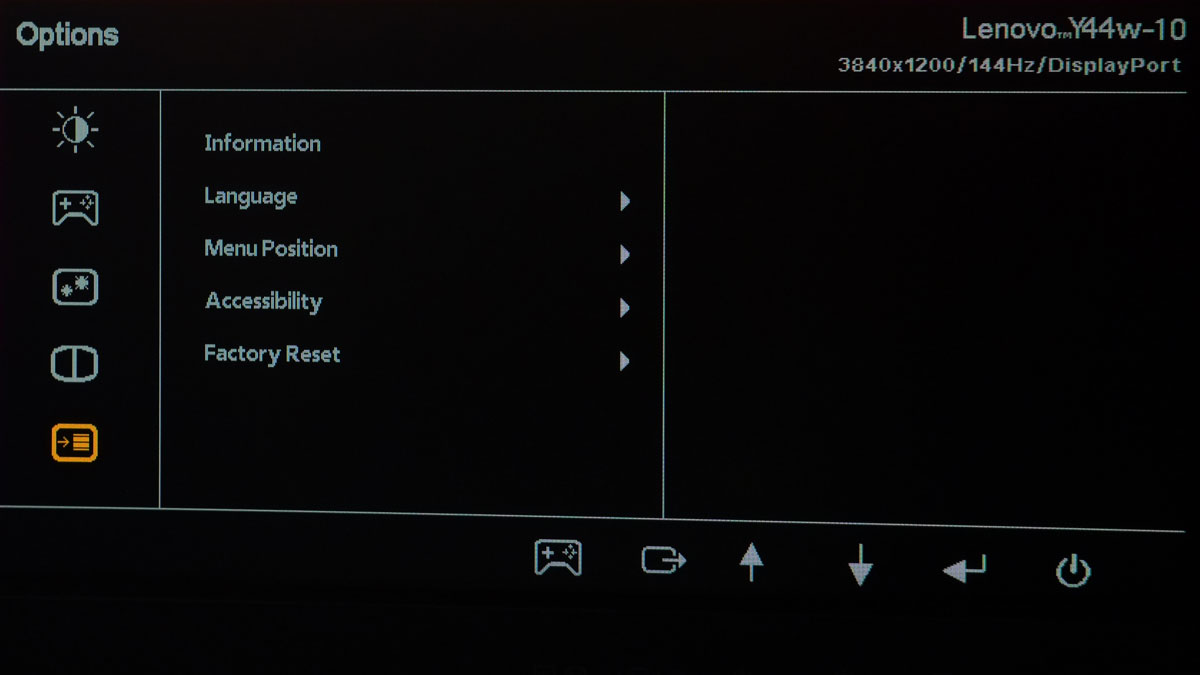
Test Setup and Methodology
Our test setup relies on the Blur Busters TestUFO Motion Tests and the Data Color Spyder5ELITE Display Calibration System. The cameras used throughout the review for the motion artifact and high speed assessments are the Fujifilm XE-1 and the Nikon 1 J1.
| Test System Specifications | |
| CPU | Intel Core-i5 6600K |
| Motherboard | ASUS Z170-A |
| Cooler | Noctua NH-L9i |
| Memory | ADATA Premier DDR4 |
| GPU | ASUS ROG Strix GTX 1060 OC |
| Storage | Crucial BX200 480GB |
| Case | Thermaltake Core P3 |
| PSU | CORSAIR RM850X |
| Display | DELL U2715H |
| OS | Microsoft Windows 10 Pro |
Target for calibration is a 2.2 Gamma value, with a White Point at 6500K and a Brightness value set at 120 cd/㎡. Calibrated values are then analyzed with the Spyder5ELITE Display Analysis tool. Do note that Dynamic Contrast Ratio and other extra features built within the OSD are disabled during the tests. The following OSD values are selected for the display calibration.
| OSD Settings | |
| Brightness | 30 |
| Contrast | 75 |
| Saturation | 50 |
| Temperature | Neutral |
| Gamma | NA |
| Preset | Default |
If you wish to use the calibrated ICC profile taken from our Spyder5ELITE result, just send us a message. You may also read our guide on how to use ICC profiles.
Color Gamut
The Color Gamut test evaluates the color spaces the display exactly covers. That includes industry standard spaces such as sRGB and AdobeRGB. Higher percentage values are better.
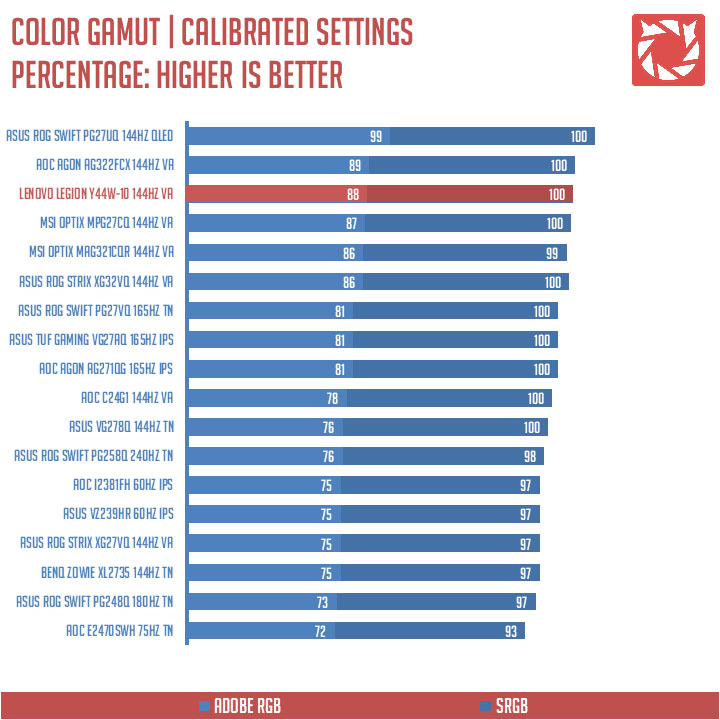
sRGB color coverage is spot on 100%, while we have 88% coverage at AdobeRGB. Excellent initial results I must say.
Tone Response
Tone response is where we check the display’s Gamma value and or presets if there are any. We then compare the results with industry standard of 2.2. Closer to this value is better.
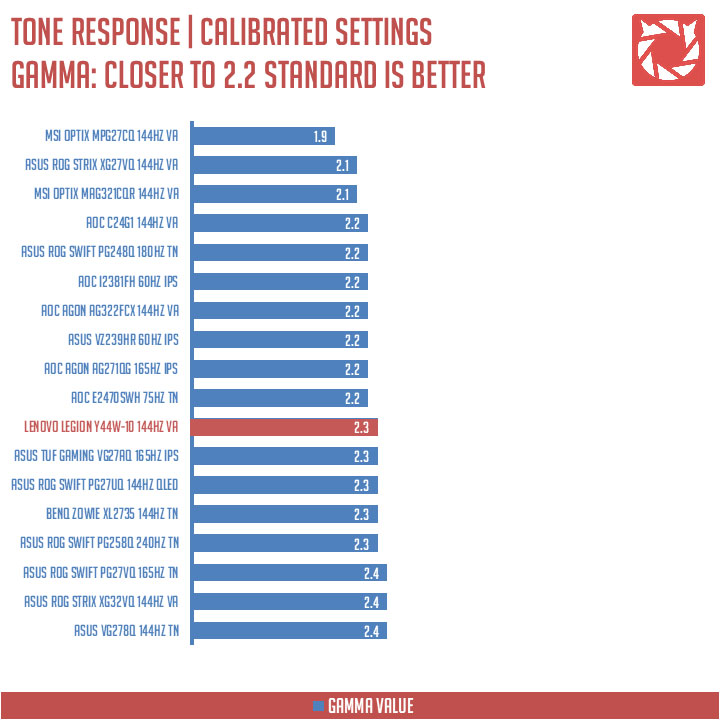
Tone response at our calibrated setup shows that this monitor has a gamma value of 2.3. Without calibration, you may reach that value with the reddish OSD option in conjunction with the default profile. A gamma level of 2.2 is hardly achievable.
Brightness
The result of the test here will shows us an overview on how the display actually performs in terms of Brightness measured in candela per square meter (cd/m2). Higher is better.
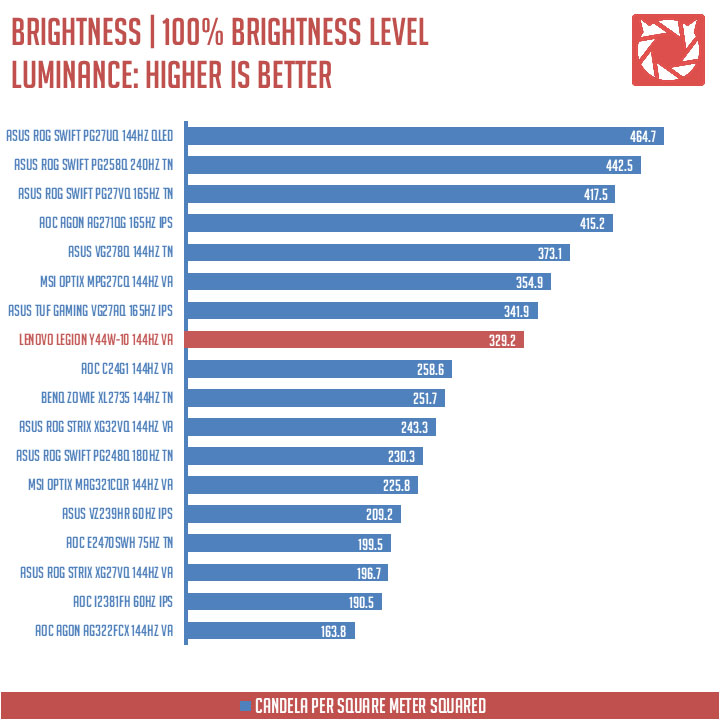
Panel brightness at 100% is rated at 329.2 cd/㎡ which is lower than the specified 450 nits. DisplayHDR 400 requires at least 400 but we’ll let it pass like many displays on the list. Use this as a general guideline.
Contrast Ratio
Static contrast ratio is also tested. The test here will shows us an overview on how the display actually performs in terms of Contrast measured in luminance ratio. Higher is better.
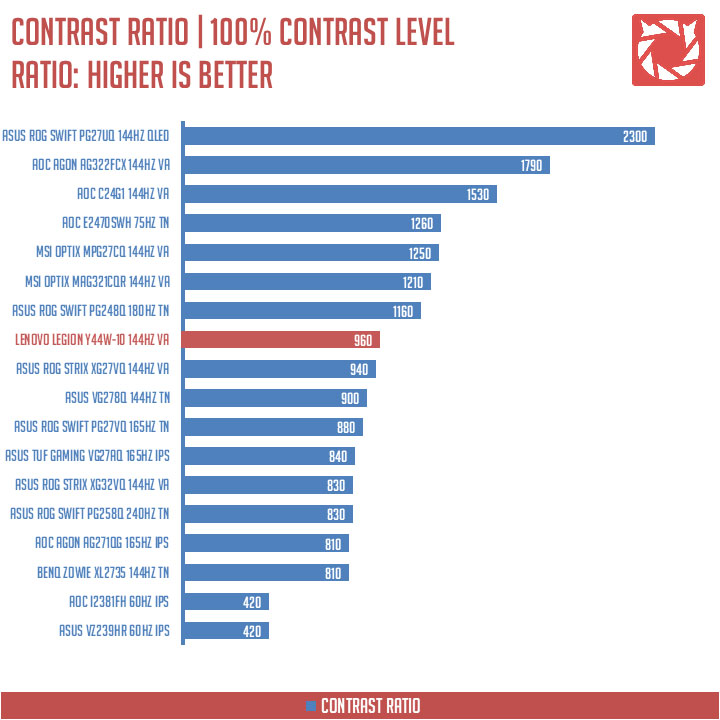
The static contrast ratio at 100% contrast level is at 960:1. Again, far behind the specifications but let’s not fault the display here since all of the monitors tested went through the same procedures.
Screen Uniformity
This test shows us an overview of the screen’s uniformity at the calibrated brightness level. The closer this value to 0, the better the quality of the panel.
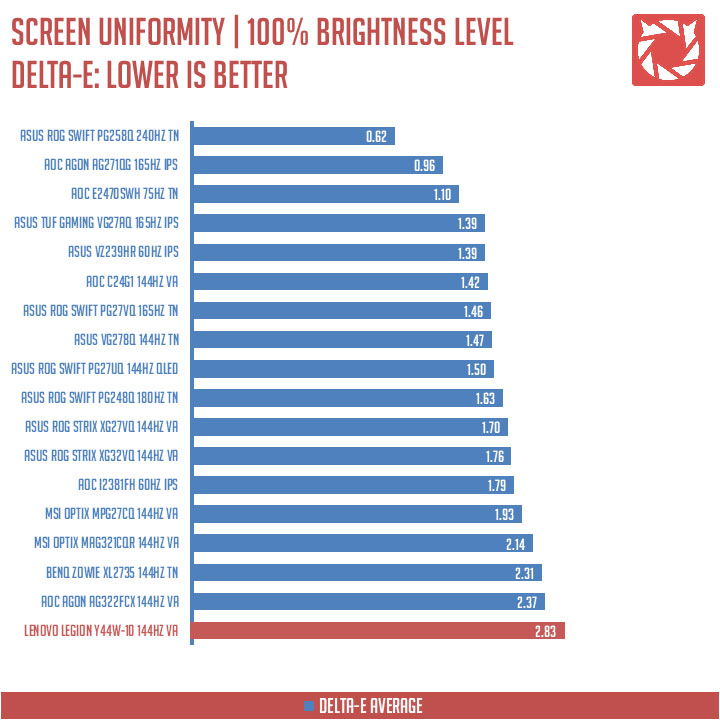
Now if there’s something we could nitpick out of this ultra-wide display, it has to be the screen uniformity. It has the worst out of all the monitors tested, especially around the lower left and right corners. Those areas are the real offenders.
Color Accuracy
This test shows how well different basic color hues are being reproduced by the display. These color tones correspond with the Datacolor SpyderCheckr. Lower Delta-E values are better.
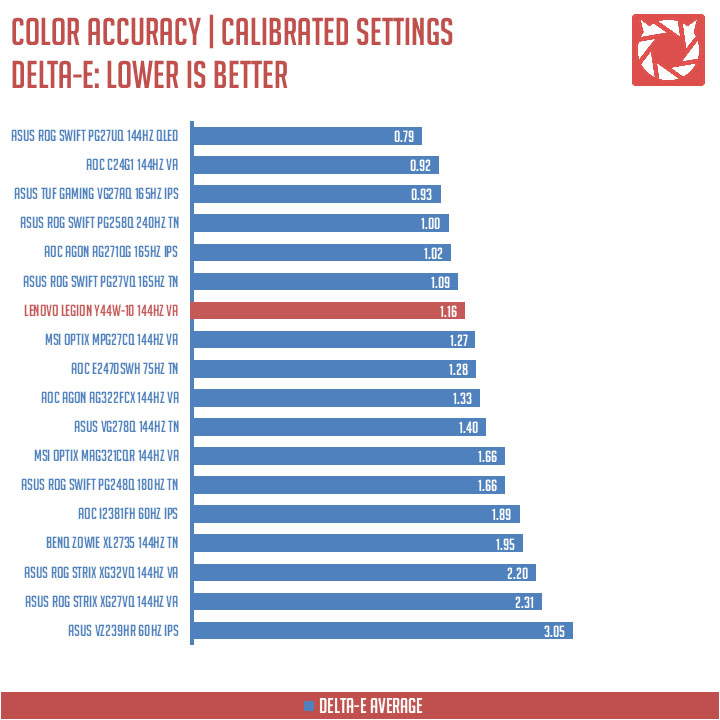
The Legion Y44W-10 scored an average of 1.16 Delta-E value. Above average which is good and well enough for content creators. Certainly, this goes hand to hand with the excellent gamut as well.
Power Consumption
The power consumption is checked with a power meter. Measurements are taken at maximum brightness level.
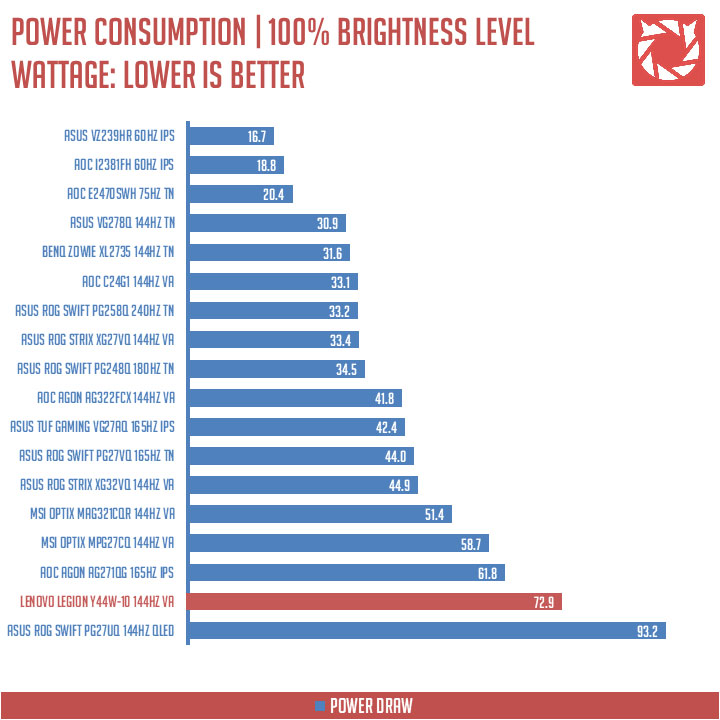
72.9W is actually pretty good for a 44 inch display. This is without the smart power saving and at full 100% brightness as well.
Button to Pixel Input Lag
The Button to Pixel Input Lag is a combination of system latency from the point of input, processing and display output. That is the basic of it and to quantify the approximate Button to Pixel Input Lag, we utilized Quake 3 Arena as our main shooter. The game is set at the native resolution of the panel with the FPS locked at 250. We check how much delay in milliseconds it took the display to actually output the signal via a 1200 FPS high-speed camera with ~0.83ms of accuracy.
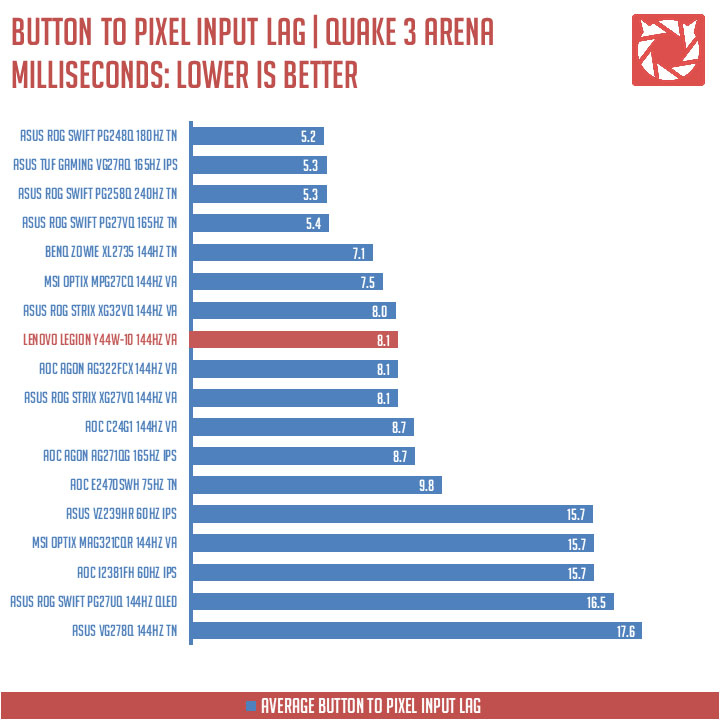
Our button to pixel input lag results shows that the Lenovo Legion Y44W-10 has an average latency of 8.1ms. The 8th fastest in the hierarchy as far as our benchmarks are concerned.
Motion Clarity: MPRT
Motion Picture Response Time (MPRT) is the numbered approach to demonstrate the level of perceived motion blur on a display. Basically, a lower persistence value indicates less motion blur. Refresh rate and the sampling method plays a major part here whereas a higher refresh rate nominally features better display persistence values.
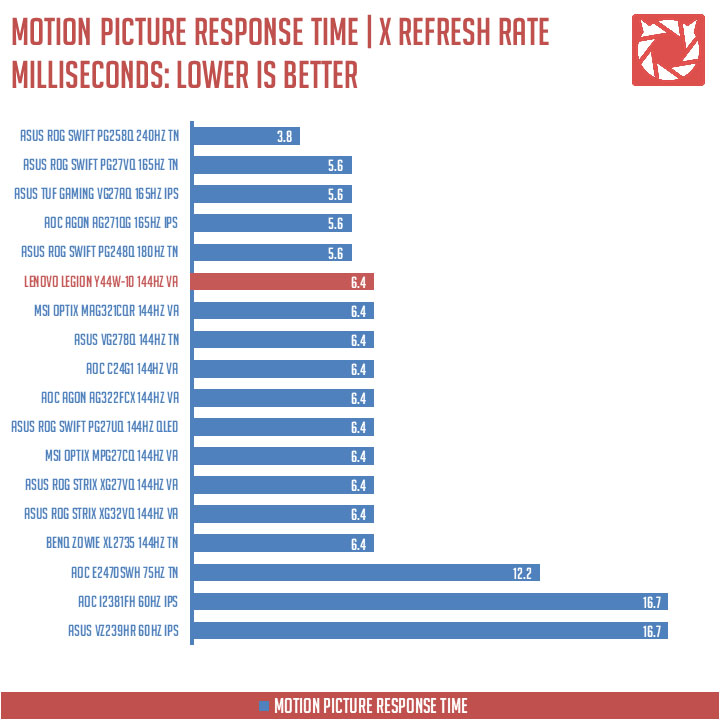
These results are references to check out the theoretical MPRT values of a display.
Motion Clarity: Pursuit Camera
Setting up a pursuit camera courtesy of Blur Busters allows us to a great extent, perceive the actual motion blur of the display. Using such method also allows us to check out for other motion artifacts including ghosting, inverse ghosting and other artifacts. This pursuit camera test is a peer-reviewed invention.
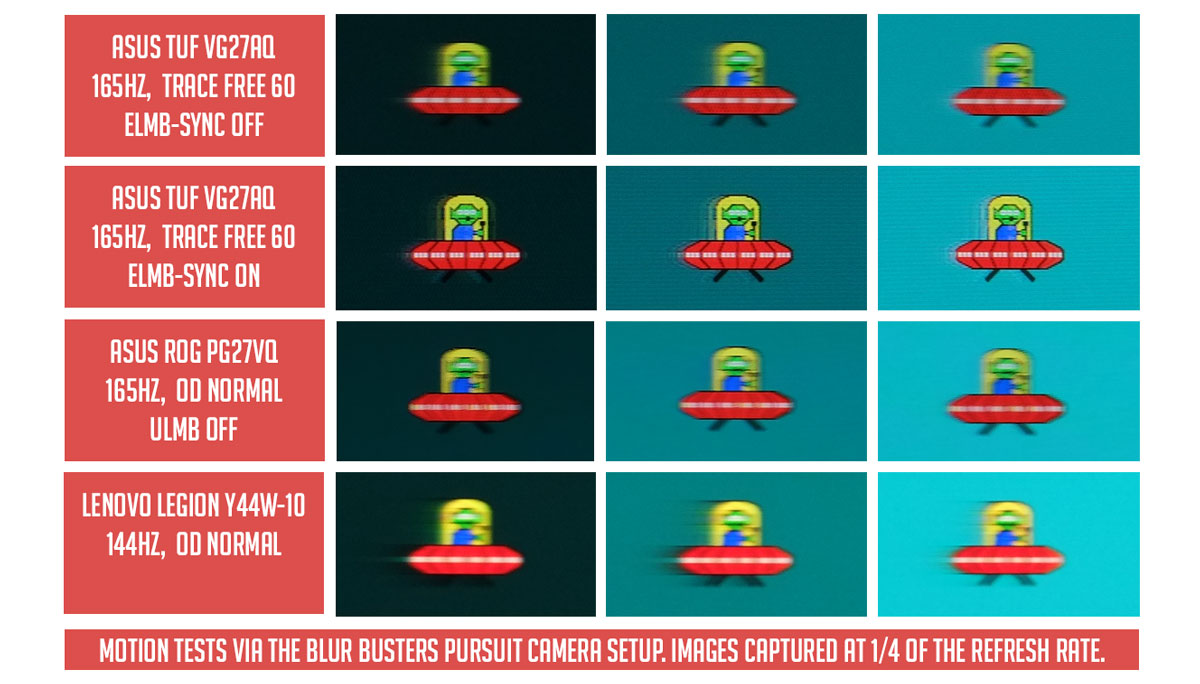
We have good results here fellas but it isn’t as crisp as any other displays at 144Hz on the bench with overdrive turned on. Mind you, the output is actually pretty good. I just can’t stand the overdrive function’s err… lack of functionality – ghosting is just honestly the same whatever option we choose.
Backlight Bleed
Backlight Bleed is the phenomenon where backlighting from a display leaks. This is prevalent with LED backlight enabled displays where the LEDs used to light the panel are situated at the edges of the display. Testing the Backlight of the display is conducted on a dim room, simulating the recognizable amount of bleed for such scenario.

The Lenovo Legion Y44W-10 features a slight backlight bleed at the lower left and right part of the panel. Can’t really see it much at the picture above but it’s there when you look for it especially at the extreme angles.
Viewing Angles
Viewing angles are also tested to check out how the display panel performs on various positions. This should be helpful if you are looking for a panel that could be used on multi-monitor setups.
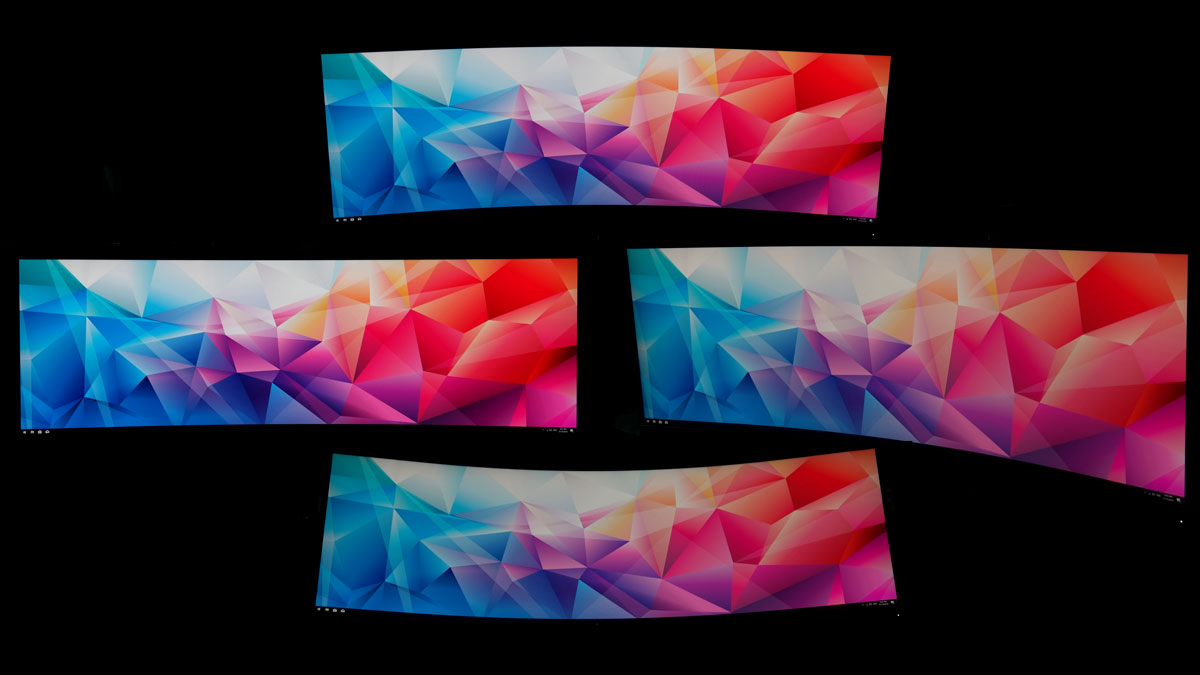
Viewing angle is good – as expected from a VA panel. Switching to a black screen you’d see uniformity issues though, as seen on our screen uniformity results.
Frame Skipping
Frame Skipping is the phenomenon where dropped frames and missing refreshes occur due to ineffective refresh rate overclocking. If your display exhibits such issues, it should be perceptually similar to in-game frame skipping. We are are utilizing the Blur Busters Frame Skipping Checker to test if there is any.
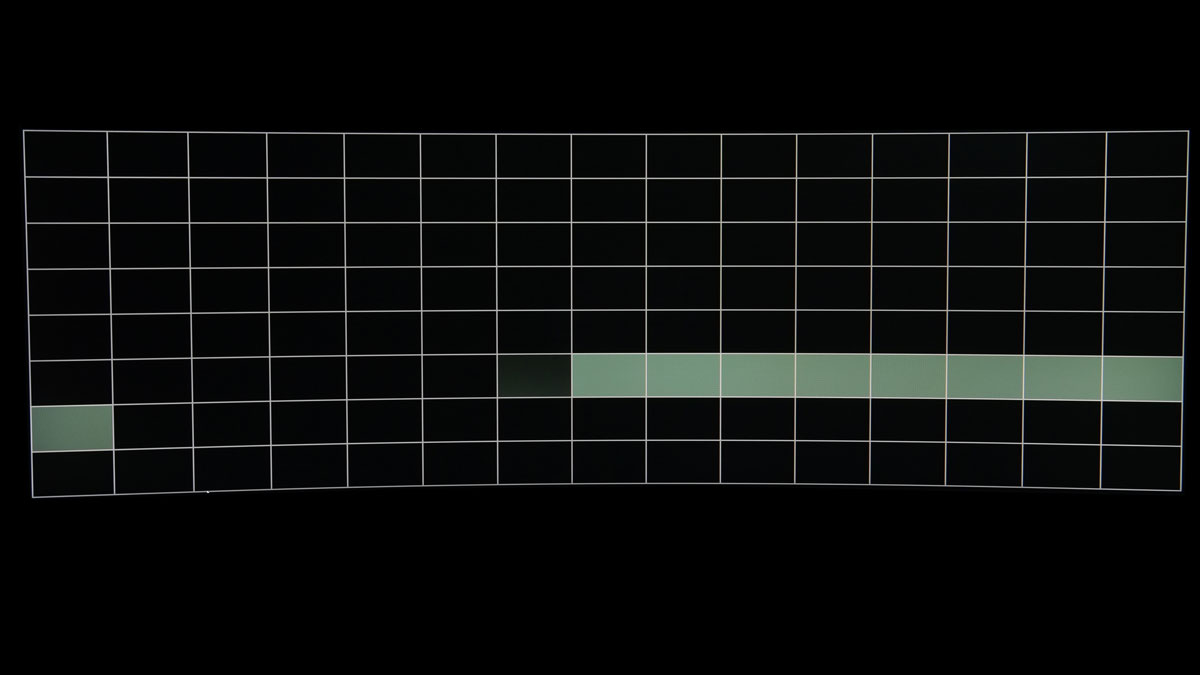
No worries here when it comes to our frame skipping test. Let’s carry on.
Software, Lighting and Special Features
The Lenovo Legion Y44W-10 supports a maximum of 144Hz so it’s a pretty smooth display to game on. This is also an AMD FreeSync 2 based display, meaning it supports variable refresh rate even on HDR contents. What you need is a FreeSync 2 compatible graphics card to make use of this feature. More about HDR later.

Now the Lenovo Legion Y44W-10 also a curved gaming monitor with 1800R of curvature. Compared to your usual panels, curved monitors allows for a much better FOV, enhances viewing angles and alleviates eye strain. It’ll take some time to get used to them but I assure you it is worth it – especially with the ultra-wide 44 inch screen space.
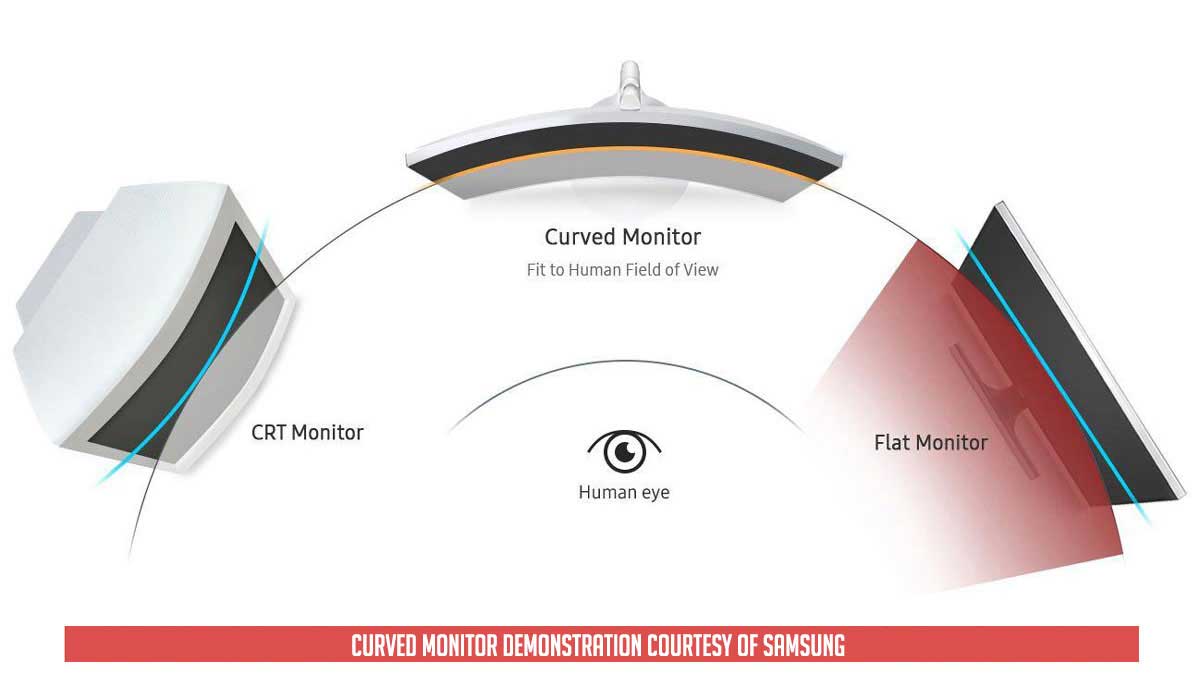
Now the Legion Y44W-10 supports HDR mode in compliance with VESA’s DisplayHDR 400 standard. Like the crowd favorite ASUS TUF Gaming VG27AQ, this doesn’t support local dimming yet it has DCI-P3 color space and 10-bit colour depth (8-bit + FCR). There are improvements, but not that great compared to true HDR monitors with local dimming.
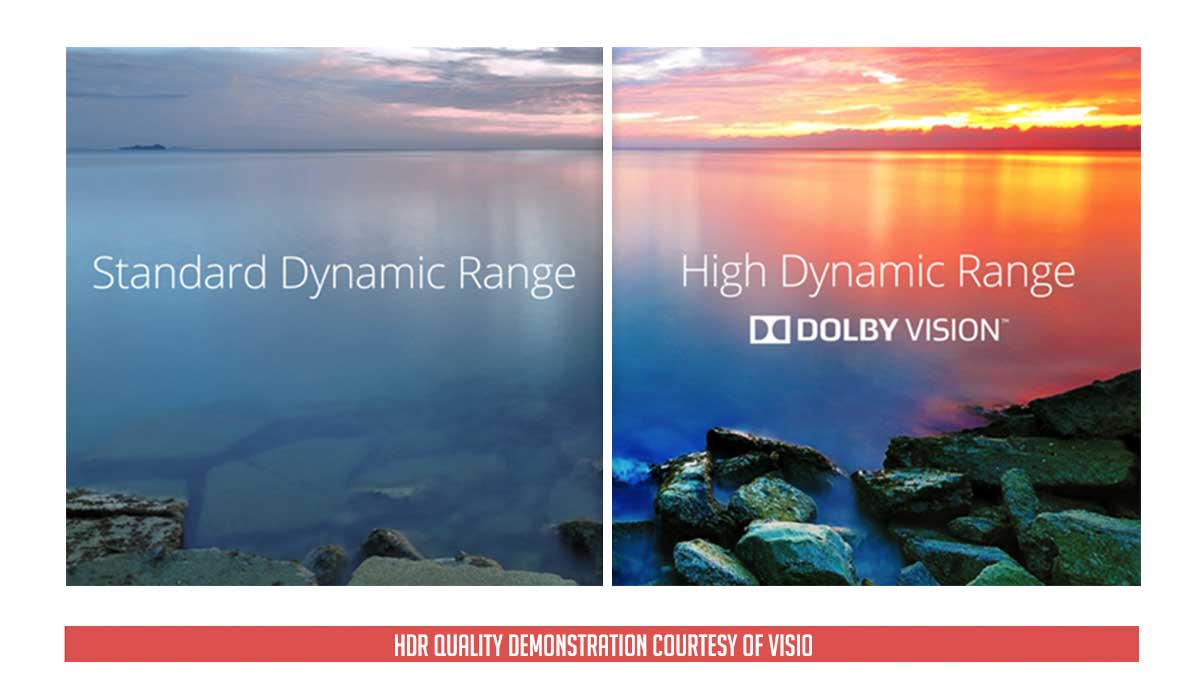
The Y44W-10 is undoubtedly marketed for gamers yet its ability to allow PIP and PBP modes elevates that ten-fold. If you are a content creator, a budding artist or even your average multi-tasker, this is also a very much appreciated feature. The addition of a KVM switch is good but it is not that user friendly since the settings you need to access the feature is buried within the OSD.
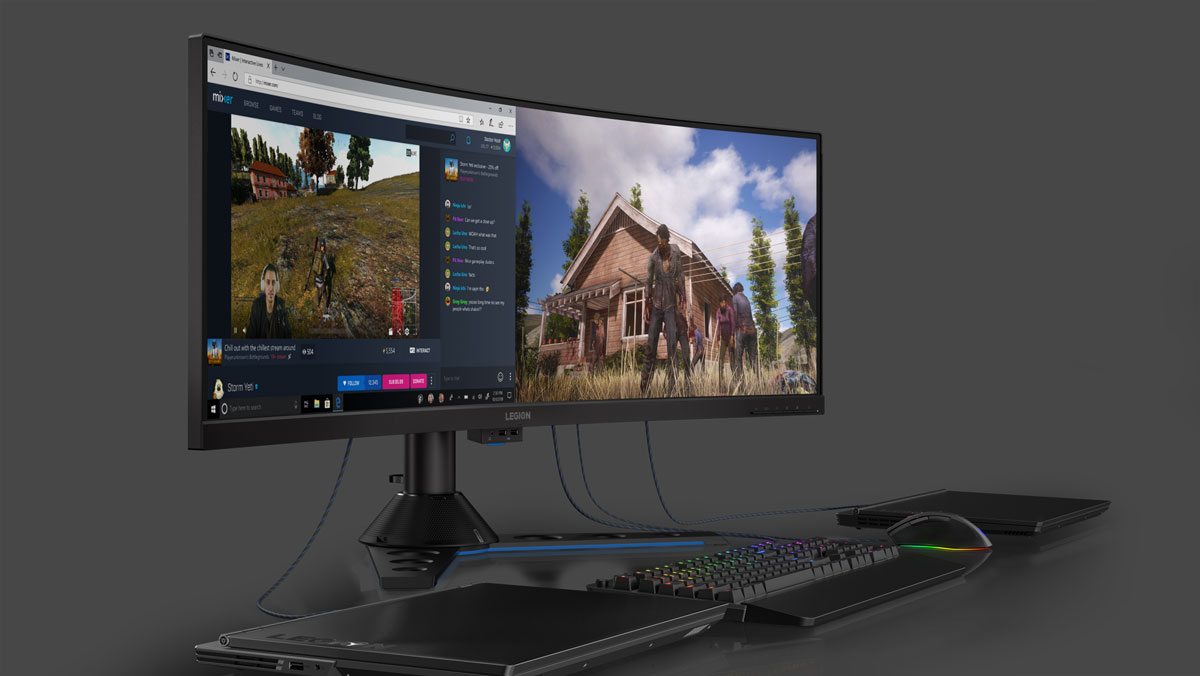
Now the speakers are by definition, not built nor made by Harman Kardon. Hence, it is called “Harman Kardon Certified”. Regardless of who really made the speaker, it received their certification so it should be all good. I never had the chance to use this for prolonged periods of time but I could tell it is way better than your usual behind the monitor speaker setup. It is removable too, so feel free to use it anywhere permitted. The thing lights up too but I’d rather have that one disabled for a more distraction free gaming.
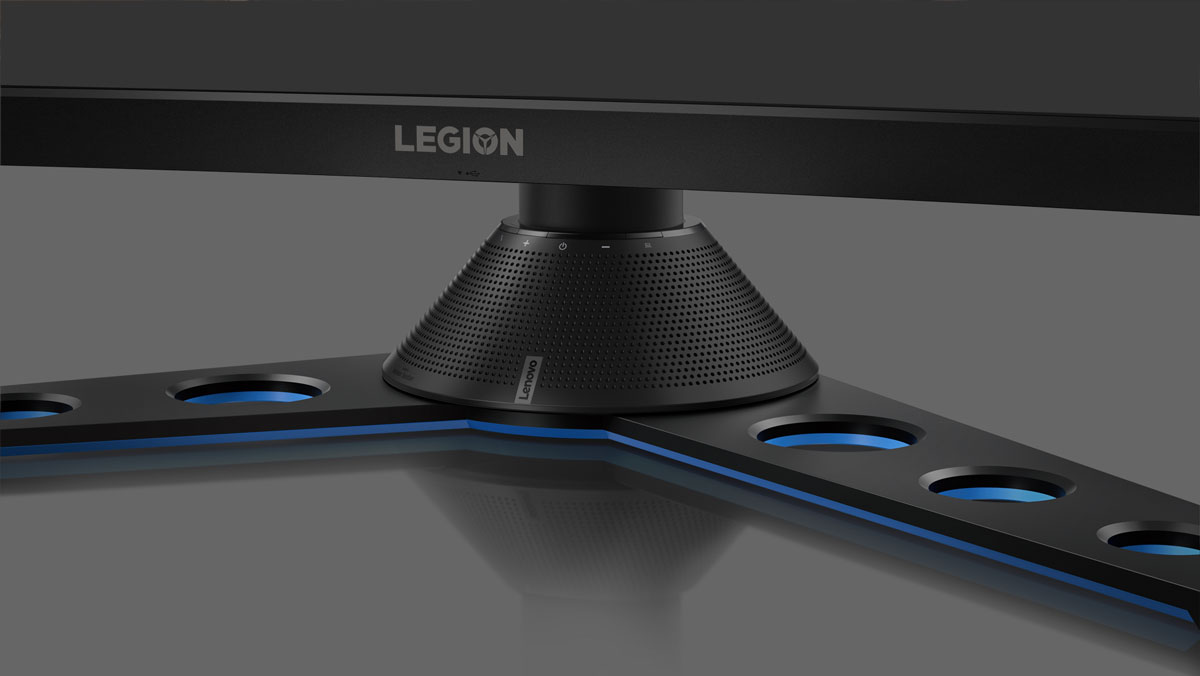
Final Thoughts
Lenovo did a great job with the Legion Y44W-10. It is just a capable ultra-wide display with promising features built for gamers, content creators and everything in between. It is basically two 24 inch monitors in one curved panel – with their functionalities as well.
Now the Y44W-10 could really use calibration out of the box. Once it does, you’d be surprised with its color accuracy paired with a great color space coverage. Screen uniformity is something to bear in mind though even it only inhibits at the lower left and right side of the panel. HDR should be a major feature, yet it doesn’t feature local dimming so I guess that’s really it for DisplayHDR 400 certified displays. Lucky for you, there are still improvements both in brightness and color reproduction due to the increased brightness, 8-bit +FCR and wider DCI-P3 gamut.
As for gaming, you cannot really fault this one – minus the overdrive. I’d rather have the option to enable or simply disable it over the inclusion of the worthless third option. Still, this is a 144Hz display with about 6.4ms of MPRT. Enough even for competitive gaming. Sadly, the support for gaming at 32:10 aspect ratio is next to zero – something that Lenovo had to forgo for a balanced compromise between multi-tasking and gaming.
Now pricing is about 59, 995 Pesos. Expensive and so does any other higher end displays. Luckily enough, this is actually one of the better ultra-wide options around that price bracket, where 100-120Hz displays with lesser screen space are found.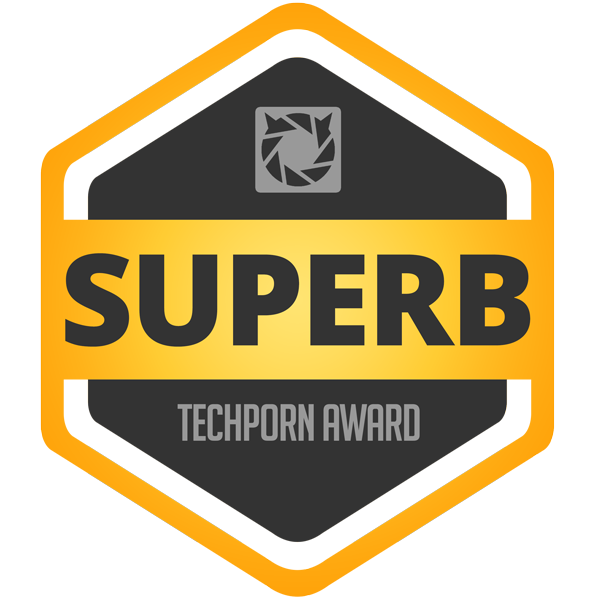
Lenovo Legion Y44W-10 44" Curved Ultra-Wide Gaming Monitor Review
-
Performance - 8/10
8/10
-
Build Quality - 9/10
9/10
-
Features - 9/10
9/10
-
Design - 8/10
8/10
-
Value - 8/10
8/10
Summary
Lenovo did a great job with the Legion Y44W-10. It is just a capable ultra-wide display with promising features built for gamers, content creators and everything in between. It is basically two 24 inch monitors in one curved panel – with their functionalities as well.
Pros
- 144Hz VRR capable 44″ panel
- Astounding build quality
- Strong gamut and color accuracy
- Competitive price point
- Connectivity options
- KVM capable
Cons
- Screen uniformity
- Gamma levels
- Local dimming not supported
- KVM function buried at the OSD
Great review. Hope you are also able to review the XG43VQ as it seems to be the only other high refresh rate super ultrawide released recently. Also ASUS claims it has a 1ms MPRT so I’m interested to see how it fares in your testing.